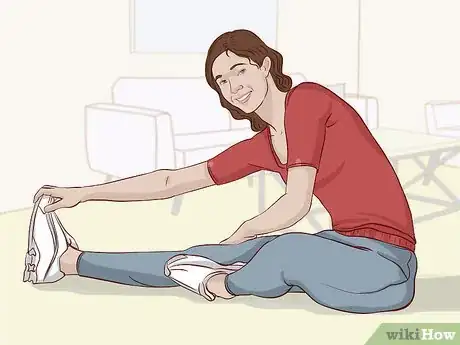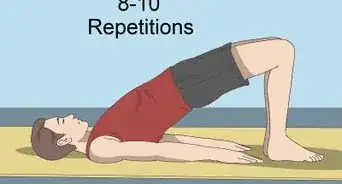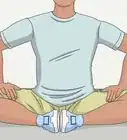This article was co-authored by Laila Ajani. Laila Ajani is a Fitness Trainer and founder of Push Personal Fitness, a personal training organization based in the San Francisco Bay Area. Laila has expertise in competitive athletics (gymnastics, powerlifting, and tennis), personal training, distance running, and Olympic lifting. Laila is certified by the National Strength & Conditioning Association (NSCA), USA Powerlifting (USAPL), and she is a Corrective Exercise Specialist (CES).
There are 12 references cited in this article, which can be found at the bottom of the page.
This article has been viewed 9,529 times.
Whether you’re a novice in the exercise world or a regular at your gym, it can be hard to gear yourself up for a hard workout. You might be tired, hungry, busy, or one of a hundred other excuses for skipping a sweat session, but you’ll absolutely feel better physically and emotionally if you make yourself get in a workout. Remember to not push yourself to the point of pain, though, and always stop exercising if you get dizzy.
Steps
Fueling up before Your Workout
-
1Prioritize a good night’s sleep the evening before a tough workout. Being well-rested will help your body perform better, so make sure to get into bed at a reasonable hour. Everyone needs a different amount of sleep, but between 7-9 hours of sleep should generally leave you feeling rested and energized the next day.[1]
- An added bonus of exercising is that it could help you sleep better at night. And better sleep can lead to better workouts. It’s a healthy cycle to get into!
-
2Drink water throughout the day so you step into your workout hydrated. While drinking water during and after a workout is important, it’s also helpful to already be hydrated when you begin. Sip on water throughout the day so that you’re not dehydrated when you’re trying to execute a vigorous exercise routine.[2]
- Dehydration makes your body work harder and can make it more difficult for you to exercise.
- If you’re exercising in the morning when you first get up, try to drink a glass of water as soon as you get out of bed to jumpstart your hydration.
- Conversely, having too much liquid in your body when you’re trying to work out might make you feel sick. Avoid pounding an entire bottle of water right before a workout—instead, drink 3–4 ounces (85–113 g) at the beginning and continue sipping as you exercise.
Advertisement -
3Eat a protein-rich snack 1-2 hours before your workout to fuel your body. Remember to eat full meals for breakfast, lunch, and dinner rather than skipping meals. Add in snacks as needed, and plan on a protein-rich snack about an hour before your workout. Your body is going to expend a lot of energy and you need fuel to get through! Consider some of these snack ideas:[3]
- Eat 1⁄2 cup (120 mL) of Greek yogurt with a small handful of mixed berries and a drizzle of honey.
- Enjoy 1-2 hard-boiled eggs and a small handful of almonds.
- Pair a banana with 2 tablespoons (30 grams) of peanut butter.
- Drink a 6–8 oz (170–230 g) fruit smoothie with a scoop of protein powder.
- Eat 1-2 turkey and cheese rollups.
-
4Take a performance supplement to increase your energy during a workout. Supplements can help you get through a hard workout and reduce your recovery time afterward. Look for supplements that contain protein, iron, creatine, caffeine, HMB (beta-hydroxy-beta-methylbutyrate), or beetroot or beet juice.[4]
- Generally, it’s best to take a performance supplement about 30 minutes before a workout, but always read the instructions before using.
- If you take medications or have any medical conditions, always check with your doctor to make sure it’s safe for you to take a performance supplement.
Warming Up
-
1Spend 12-18 minutes warming up to prevent muscle strain and injury. Getting the blood flowing is a great way to prepare your body for a hard workout. You’ll be able to jump into the harder parts of your routine with more ease; plus, you’ll reduce your chance of getting hurt. When planning your workouts, make sure to include time for a good warmup.[5]
- Not taking the time to warm up can make it more likely that you’ll injure yourself. If you injure yourself, you’ll have to take time away from working out so that you can heal.
-
2Spend 5-10 minutes of your warmup doing some kind of light cardio activity. A little bit of cardio will gently increase your heart rate and get the blood flowing to all your limbs. Even if you’ll primarily be weight lifting or strength training, a little cardio at the beginning of your workout will be beneficial. Here are some ideas:[6]
- Jump rope.
- Walk on the treadmill.
- Run in place.
- Do jumping jacks and mountain climbers.
-
3Stretch your neck, shoulders, wrists, and ankles to loosen your limbs. These parts of the body are often overlooked, but they do so much for your body, especially when you’re exercising! Take 2-3 minutes to warm up these areas so they’re less likely to get hurt.[7]
- Roll your wrists and ankles in small circles, 20 times each.
- Flex your neck forward, backward, and to the sides 10 times. Hold each stretch for 2-3 seconds.
- Roll your shoulders forward 10 times and backward 10 times.
-
4Do 5 minutes of dynamic stretching to prepare your body for movement. When you warm up by continuously moving your muscles, rather than holding a specific position for an amount of time, you’re doing a dynamic stretch. It’s a practice that helps you loosen your muscles and warm up your limbs at the same time. Here are some examples of dynamic stretches you can incorporate into your warmup routine:[8]
- Use a foam roller on your shoulder blades and mid-upper back to loosen your muscles.
- Do a set of 10 side lunges to warm up your hamstrings.
- Warm up your core by squatting and then walking your hands forward until you’re in a plank. Do this 10 times.
- Stand in place with your legs hip-width apart. Twist your torso slowly from side-to-side 20 times. This helps warm up your spine.
Exercising Safely
-
1Drink 20–32 ounces (570–910 g) of water during your workout to stay hydrated. Your muscles will get tired faster if they’re dehydrated; plus, it’ll take a lot longer for you to recover afterward if you’re feeling fatigued from dehydration. Bring a big water bottle with you and stop every 5-10 minutes to drink some water.[9]
- If you’re exercising in high-heat, you may need to drink even more water.
- Refill your water bottle after your workout and keep drinking for the next 30 minutes or so. Your body continues to sweat even after you’ve stopped exercising, so you’re still losing fluids. Try to replenish with about 16 ounces (450 g) of water.
- Depending on your workout, it may be hard to stop and take a quick break for water. Try to prioritize it as much as you can, though.
-
2Take a break if you feel lightheaded or experience abnormal pain. When you work out, it’s normal to feel a certain range of discomfort as you work different muscles, but the pain should never be sharp or extended. Pushing through if you feel dizzy or in pain could result in serious injuries.[10]
- For example, when lifting weights, it’s normal to feel a kind of burning sensation as your muscles work. However, if you feel a stabbing pain in your shoulder every time you complete a repetition, that’s a sign that you should stop.
-
3Cool down for 10 minutes by walking or stretching. Once you finish your hard workout, take a beat and cool down before heading home. This helps lower your heart rate and allows you to catch your breath.[11]
- This is a great time to drink some more water!
Expert Q&A
-
QuestionHow much cardio should I do before lifting?
 Laila AjaniLaila Ajani is a Fitness Trainer and founder of Push Personal Fitness, a personal training organization based in the San Francisco Bay Area. Laila has expertise in competitive athletics (gymnastics, powerlifting, and tennis), personal training, distance running, and Olympic lifting. Laila is certified by the National Strength & Conditioning Association (NSCA), USA Powerlifting (USAPL), and she is a Corrective Exercise Specialist (CES).
Laila AjaniLaila Ajani is a Fitness Trainer and founder of Push Personal Fitness, a personal training organization based in the San Francisco Bay Area. Laila has expertise in competitive athletics (gymnastics, powerlifting, and tennis), personal training, distance running, and Olympic lifting. Laila is certified by the National Strength & Conditioning Association (NSCA), USA Powerlifting (USAPL), and she is a Corrective Exercise Specialist (CES).
Fitness Trainer I wouldn't even consider it cardio since your goal isn't to raise your heart rate for a sustained period of time. You just want to give your heart rate a little boost. You could even do this by walking! I'd typically recommend 10-15 minutes, though.
I wouldn't even consider it cardio since your goal isn't to raise your heart rate for a sustained period of time. You just want to give your heart rate a little boost. You could even do this by walking! I'd typically recommend 10-15 minutes, though. -
QuestionIs there anything I can do to get my heart rate up that doesn't involve running or walking?
 Laila AjaniLaila Ajani is a Fitness Trainer and founder of Push Personal Fitness, a personal training organization based in the San Francisco Bay Area. Laila has expertise in competitive athletics (gymnastics, powerlifting, and tennis), personal training, distance running, and Olympic lifting. Laila is certified by the National Strength & Conditioning Association (NSCA), USA Powerlifting (USAPL), and she is a Corrective Exercise Specialist (CES).
Laila AjaniLaila Ajani is a Fitness Trainer and founder of Push Personal Fitness, a personal training organization based in the San Francisco Bay Area. Laila has expertise in competitive athletics (gymnastics, powerlifting, and tennis), personal training, distance running, and Olympic lifting. Laila is certified by the National Strength & Conditioning Association (NSCA), USA Powerlifting (USAPL), and she is a Corrective Exercise Specialist (CES).
Fitness Trainer You could start lifting with roughly 40% of your planned weight. In other words, if you're going to bench 150 pounds during your normal workout routine, you could do a set with 60 pounds instead. This should have the same relative effect.
You could start lifting with roughly 40% of your planned weight. In other words, if you're going to bench 150 pounds during your normal workout routine, you could do a set with 60 pounds instead. This should have the same relative effect.
Warnings
- If you’ve had health problems or aren’t used to hard workouts, talk to your doctor first to make sure it’s safe for you to follow a strenuous exercise plan.[16]⧼thumbs_response⧽
- You might be overheating if you get a headache or experience dizziness or nausea. Cool down, drink some water, and see if you feel better before resuming your workout.[17]⧼thumbs_response⧽
- Make sure to dress appropriately for the weather. Overheating or getting too cold can be dangerous.[18]⧼thumbs_response⧽
References
- ↑ https://www.ncbi.nlm.nih.gov/pmc/articles/PMC4341978/
- ↑ https://healthengine.com.au/info/preparing-for-exercise
- ↑ https://www.acefitness.org/education-and-resources/lifestyle/blog/3532/pre-and-post-workout-snacks-for-different-workout-durations/
- ↑ https://ods.od.nih.gov/factsheets/ExerciseAndAthleticPerformance-Consumer/
- ↑ https://www.health.harvard.edu/healthbeat/10-tips-for-exercising-safely
- ↑ Laila Ajani. Fitness Trainer. Expert Interview. 31 October 2019.
- ↑ https://www.health.harvard.edu/healthbeat/10-tips-for-exercising-safely
- ↑ https://www.acefitness.org/education-and-resources/lifestyle/blog/3456/a-new-approach-to-warming-up-for-your-cardio-workout/
- ↑ https://www.acefitness.org/education-and-resources/professional/expert-articles/6390/meal-timing-what-and-when-to-eat-for-performance-and-recovery/
- ↑ https://www.health.harvard.edu/healthbeat/10-tips-for-exercising-safely
- ↑ https://www.health.harvard.edu/healthbeat/10-tips-for-exercising-safely
- ↑ https://www.goodhousekeeping.com/uk/health/health-advice/a561183/this-is-how-i-motivate-myself-to-exercise-5-times-a-week/
- ↑ http://www.acsm.org/docs/default-source/files-for-resource-library/high-intensity-interval-training.pdf?sfvrsn=b0f72be6_2
- ↑ https://www.runtastic.com/blog/en/7-ways-to-motivate-yourself-to-work-out-when-youre-just-not-feeling-it/
- ↑ https://www.muscleandfitness.com/workouts/workout-tips/8-things-you-should-do-every-workout-2/
- ↑ http://www.acsm.org/docs/default-source/files-for-resource-library/high-intensity-interval-training.pdf?sfvrsn=b0f72be6_2
- ↑ https://www.health.harvard.edu/healthbeat/10-tips-for-exercising-safely
- ↑ https://www.health.harvard.edu/healthbeat/10-tips-for-exercising-safely


































































